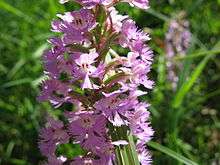Platanthera psycodes
| Platanthera psycodes | |
|---|---|
 | |
| Scientific classification | |
| Kingdom: | Plantae |
| (unranked): | Angiosperms |
| (unranked): | Monocots |
| Order: | Asparagales |
| Family: | Orchidaceae |
| Tribe: | Orchideae |
| Genus: | Platanthera |
| Species: | P. psycodes |
| Binomial name | |
| Platanthera psycodes (L.) A.Gray | |
| Synonyms | |
| |
Platanthera psycodes, commonly called lesser purple fringed orchid[1] or small purple-fringed orchid, is a species of orchid, genus Platanthera,[2] occurring from eastern Canada (from Manitoba to Newfoundland) to the east-central and northeastern United States (Great Lakes Region, Appalachian Mountains, and New England).[3][4] It is imperiled in Illinois, Tennessee, North Carolina, and Kentucky.
The specific epithet "psycodes" means butterfly-like, alluding to the shape of the flowers. Like many other orchids it is a plant of wet habitats: sedge meadows, flatwoods, sphagnum bogs, cedar or alder swamps, on stream edges or the moist edges of coniferous forests. It is occasionally found in wet swales adjoining freshwater sandy beaches. Preferring cooler habitats, its range is being pushed northwards as global temperatures warm. Correll refers to locations of 1,500 foot altitudes in Vermont, 4,000 foot altitudes in Virginia and 6,500 foot altitudes in North Carolina and Tennessee. It is often confused with its relative, Platanthera grandiflora, which generally has larger flowers (lip or labellum 10-25mm long),[5] and has a circular nectary opening, compared to P. psycodes which has smaller flowers (the labellum measuring from 5-13mm long) and an oblong or almost rectangular opening. The most important characteristic separating the two species is the shape of the column and relative placement of the pollinia on the pollinators. In "P. psycodes" the column is shaped such that the pollinia are attached to the proboscis of the pollinator whereas in "P. grandiflora" the column is larger and the viscidia of the pollinia are widely spaced and outwardly rotated. This results in the pollinia being placed on the eyes of the pollinator.[6] "P. grandiflora" has a much more restricted range and where the two species do overlap in range, they are phenotypically separated, with "P. grandiflor"a typically blooming from late June through early July while "P. psycodes" blooms from late July through early August.
References
- ↑ "Platanthera psycodes". Natural Resources Conservation Service PLANTS Database. USDA. Retrieved 7 October 2015.
- ↑ efloras
- ↑ Flora of North America v 26 p 565, Platanthera psycodes
- ↑ Biota of North America Program, county distribution map
- ↑ http://goorchids.northamericanorchidcenter.org/species/platanthera/grandiflora/
- ↑ Stoutamire, Warren P. (1974). "Relationships of the purple-fringed orchids Platanthera Psycodes and P. grandiflora". Brittonia. doi:10.2307/2805919.
- Correll, Donovan S.. Native Orchids of North America North of Mexico. Waltham: Chronica Botanica Co.. 1950
- Stoutamire, Warren P. (1974). "Relationships of the purple-fringed orchids Platanthera Psycodes and P. grandiflora". Brittonia. doi:10.2307/2805919.
External links
-
 Media related to Platanthera psycodes at Wikimedia Commons
Media related to Platanthera psycodes at Wikimedia Commons -
 Data related to Platanthera psycodes at Wikispecies
Data related to Platanthera psycodes at Wikispecies
